Bradford Gilbert
Bradford Lee Gilbert (March 24, 1853–September 1, 1911 in Watertown, New York) was an American architect based in New York City.
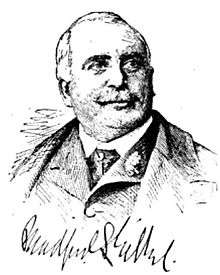
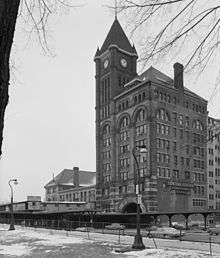
Tower Building
Gilbert is known for designing the first steel-framed curtain wall building in New York, the Tower Building, which opened at 50 Broadway in 1889.[1][2] The Tower Building is considered New York City's first skyscraper. There is some dispute as to whether the Tower Building had eleven or thirteen floors, depending on which floors were counted and which side of the building was considered.[3][4] It had to have the steel-frame construction because on its narrow lot, masonry-supporting walls would have allowed almost no free space on the first floor. Gilbert's design used the same frame as a railroad bridge, but rotated vertically.[5]
The Tower Building was initially greeted with great skepticism, with members of the public predicting it would blow over. This prompted Gilbert to scale the building in the middle of an 1889 hurricane to demonstrate with a plumb line that the building was not vibrating.[2][3] The building was razed in 1914.
Railroad stations
Gilbert had been appointed architect of the New York, Lake Erie & Western Railroad by the age of 23. Among his extensive work for multiple railroads across the country,[6][7] Gilbert also designed a previous version of New York City's Grand Central Terminal in 1898.[5]
Gilbert was the original architect for Ottawa Central Railway Station in 1910, as well as nearby Château Laurier but removed due to mismanagement concerns.[8]
Legacy
Most of his New York buildings have been demolished, but his landmark eleven story Flatiron Building (1898) still stands in Atlanta, Georgia, and predates the similar and more famous New York City Flatiron Building by five years.[9]
Gilbert was also the supervising architect for the Atlanta Cotton States and International Exposition (1895) and the South Carolina Inter-State and West Indian Exposition (1901).[10]
Albemarle Park and The Manor Inn remain intact in Asheville, North Carolina. The former resort buildings are now mostly residences in a historic district including several Bradford Gilbert designed buildings. [11]
Death
Gilbert died at his home in Brooklyn in 1911, aged 58, survived by his wife and daughter.[12]
Selected works
(listed by year built)[13]
- South Side Sportsmen's Club, Great River, New York, 1866
- New York, Lake Erie & Western Railroad Station, Avon, New York, 1879[14]
- Flint and Pere Marquette Railroad East Saginaw Depot, Saginaw, Michigan, 1881[14]
- Central Railroad & Rockaway Valley R.R. Station, Whitehouse Station, New Jersey, 1890[15]
- Central Railroad of New Jersey Station, Main Street, Whitehouse, New Jersey, 1890
- Beaverkill Lodge - Bradford Lee Gilbert's summer residence (aka Dundas Castle), Craig-E-Clair, Roscoe, New York, ca. 1891
- Laconia Passenger Station, Laconia, New Hampshire, 1892[14]
- Old Colony Railroad Depot, Canton Junction, Canton, Massachusetts, 1892[14]
- Concord & Montreal Railroad Passenger Station, Amoskeag, New Hampshire, 1892[14]
- Caldwell Railway Passenger Station, Essex-Fells, New Jersey, 1892[14]
- New York, New Haven and Hartford Depot, Bridgewater, Massachusetts, 1893[14]
- Concord & Montreal Railroad Station, Depot Street, New Boston, New Hampshire, 1893[14]
- New York, Ontario & Western Railroad Station, Low Avenue off Wickham Avenue, Middletown, Orange County, New York, 1893[14]
- New York, New Haven and Hartford Depot, North Abington, Massachusetts, 1894[14]
- Missouri, Kansas and Texas Railroad Depot, 600 East 3rd Street, Sedalia, Missouri, 1895[14]
- Flatiron Building, Atlanta, Georgia, 1897
- Boston & Maine RR Passenger Station, 10 Park Street, Beverly, Massachusetts, 1897[14]
- Albemarle Park and The Manor Inn, Asheville, North Carolina, 1898[16]
- Central Station, for the Illinois Central Railroad, Chicago, Illinois, 1893, razed 1974[14]
- Central Railroad of New Jersey Passenger Station, Lebanon, New Jersey, 1899[17]
- D.,L. & W. R.R. Passenger Station, Bernardsville, New Jersey, 1901[14]
- William G. Raoul House, Atlanta, Georgia, 1901 (destroyed by fire in 1991)
- Central Railroad of New Jersey Plainfield Twin Passenger Station, Plainfield, New Jersey, 1902
- Long Island Rail Road Passenger Station, Oyster Bay, New York, 1902
- Long Island Railroad Passenger Station and Baggage Building, Railroad Plaza, Southampton, New York, 1902
- Philadelphia & Reading Company Passenger Station, Fort Washington, Pennsylvania, 1903
- Tower Building, New York, New York, 1889, razed 1914[14]
Other
Gilbert was also heavily involved in the work of Jerry McAuley, noted missionary at the Water Street Rescue Mission in New York and continued to support the mission after McAuley's death in 1884. Gilbert was first married in 1871 in New York to Cora, daughter of Captain John Rathbone.
After his divorce, Gilbert wed Maria (Fahy) McAuley, widow of Jerry McAuley in 1892 in Cranford, New Jersey. On February 12, 1896, Bradford and Maria had a daughter, Blossom.
Gallery
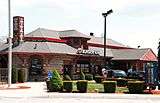 Bridgewater, Massachusetts
Bridgewater, Massachusetts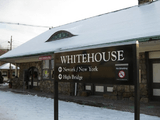 Whitehouse, New Jersey
Whitehouse, New Jersey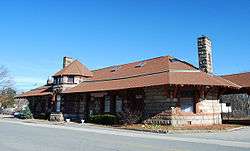 North Abington, Massachusetts
North Abington, Massachusetts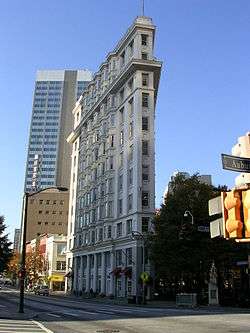 Flat Iron Atlanta, Georgia
Flat Iron Atlanta, Georgia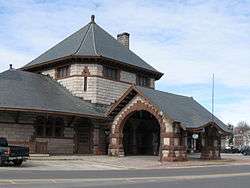 Laconia, New Hampshire
Laconia, New Hampshire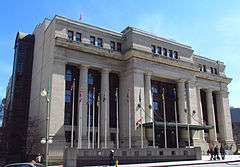
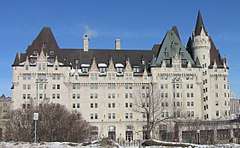
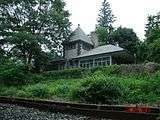 Amoskeag, New Hampshire
Amoskeag, New Hampshire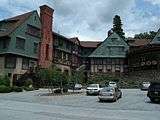 Asheville, North Carolina
Asheville, North Carolina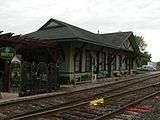 Avon, New York
Avon, New York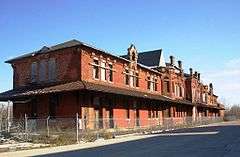 East Saginaw, Michigan
East Saginaw, Michigan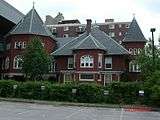 Capital Center for the Arts formerly: B. A. Kimball Residence Concord, New Hampshire
Capital Center for the Arts formerly: B. A. Kimball Residence Concord, New Hampshire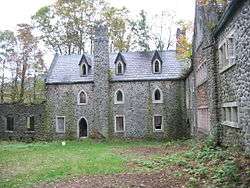 Beaverkill Lodge - Bradford Lee Gilbert's summer residence (aka Dundas Castle), Roscoe, New York
Beaverkill Lodge - Bradford Lee Gilbert's summer residence (aka Dundas Castle), Roscoe, New York
See also
- George E. Archer
- Frank J. Nies, DL&W Railroad contemporary
References
- "The Tower Building". New York Architecture. Retrieved July 5, 2007.
- Edward Robb Ellis (1997). The Epic of New York. pp. 407–08.
- Denenberg, Barry (September 1, 2010). "Skyscrapers". Magical Hystory Tour: The Origins of the Commonplace & Curious in America. Archived from the original on June 29, 2015. Retrieved August 16, 2011.
- Landau, Sarah; Condit, Carl W. (1996). Rise of the New York Skyscraper, 1865–1913. Yale University Press. pp. 161–66, 416. ISBN 978-0-300-07739-1. OCLC 32819286.
- Gray, Christopher (July 1, 2007). "The Architect Who Turned a Railroad Bridge on Its Head". New York Times. Retrieved July 5, 2007.
- Gilbert, Bradford Lee (1895). "Sketch Portfolio of Railroad Stations and Kindred Structures: From Original Designs".
- Gilbert, Sketch Portfolio of Railroad Stations (The Railroad Gazette, 1885). The book notes that his work on railroad architecture was the subject of a special exhibit at the World's Columbian Exposition (the Chicago World's Fair) in 1893, for which he received a special medal.
- Fletcher, Katharine (2004). Capital Walks: Walking Tours of Ottawa. Fitzhenry & Whiteside, Markham, Ontario. Page 73.
- "FLATIRON BUILDING (The English-American Building)". City of Atlanta. Archived from the original on September 17, 2011. Retrieved August 16, 2011.
- White, James Terry (1910). The National Cyclopaedia of American biography. XIV. p. 298.
- Merten and Sauer, Stacy and Robert (2014). Asheville’s Albemarle Park. Charleston, SC: Arcadia Publishing. ISBN 978-1-4671-2125-5.
- American Art Annual, Volume 9. MacMillan Company. 1911. p. 311.
- Coe, Daniel (2011). "Bradford Lee Gilbert's Achievements". Archived from the original on September 11, 2011. Retrieved August 16, 2011.
- Gilbert, Bradford (1895). "Sketch Portfolio of Railroad Stations from Original Designs by Bradford L. Gilbert, Architect" (PDF). The Railroad Gazette, New York City. Archived from the original (PDF) on January 8, 2017. Retrieved April 22, 2016.
- Potter, Janet Greenstein (1996). Great American Railroad Stations. New York: John Wiley & Sons, Inc. p. 162. ISBN 978-0471143895.
- Merten and Sauer, Stacy and Robert (2014). Asheville’s Albemarle Park. Charleston, SC: Arcadia Publishing. ISBN 978-1-4671-2125-5.
- Railroad Gazette. Railroad Gazette. 1905-01-01.
External links
| Wikimedia Commons has media related to Bradford Gilbert. |